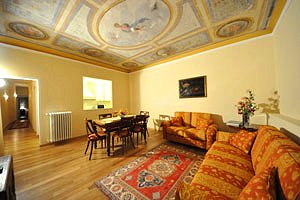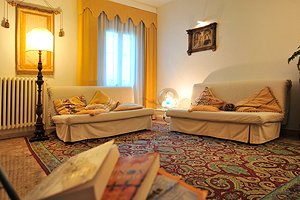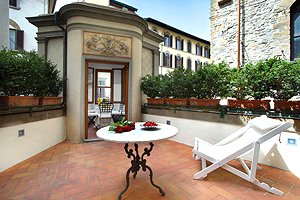A Bit of History of Florence

Even if Florence’s origins are Etruscan, the city was actually founded by the Romans in 59 B.C.. After the many barbarian invasions which preceded the Roman’s dominion on the city, Florence become an independent commune. It was governed by rich merchants, powerful members of the clergy, and outstanding noble families. In that time the city was divided in two hostile factions: the Guelphs, who supported the Pope and the Ghibellines, who supported the Emperor. Despite the rivalry between these two political groups, Florence, thanks to its famous wool and silk trade, fastly become a powerful city.
During the 13th century Florence was one of the most important european boomtowns. This period of economical prosperity came to the end with the Hundred Years War, when the Florentine banks suffered a big crisis (mainly due to the financial insolvency of the King of England Edward III and the catastrophic outbreak of the Black Death of 1348).
The lower classes grew intolerant toward the Major Guilds and finally revolted against them in a popular riot known as “Ciompi” uprising. New Guilds come to life but quickly began to oscillate. The city split in two different parts: on the one hand stayed those who supported the old oligarchy, represented by the Albizi family, while, on the other hand, stayed those who supported a more modest class, represented by the Medici family.
With the dinasty of the Medici family Florence lived a long period of wealth. In 1434 Cosimo the Elder of Medici family made the city into a Signoria. His grandson Lorenzo the Magnificent strongly contributed to the supremacy and the prestige of Florence by forging alliances with some powerful families of other cities as Naples and Milan.
Though during the first part of the 16th century Florence lived some difficult political moments, its grandeur lasted until 1737, when, Gian Gastone, the last member of the family, died leaving no heirs. It was then that Tuscany was assigned to Francesco Stefano of Lorraine, the husband of Maria Teresa, the Empress of Austria. It began a long period of close connection between the region and the Hapsburg-Lorraines family.
Whit the burst of the French Revolution Tuscany came under French control. However, the Lorraines reclaimed power with Ferdinando III until 1860, the year in which the Grand Duchy was annexed to Italy, commanded by the King Vittorio Emanuele II of Savoy. From 1865 to 1870 Florence, as Italy’s capital, enjoyed a period of drastic urban changes which improved both its architectural image and its industrial develpoment.
As many other italian cities, during World War II, Florence was heavily bombed and centuries-old sections of it were completely destroyed. Though almost completely devastated, the city could preserve an old image of its look: Ponte Vecchio one of the city’s bridges, now become an urban symbol of Florence, was spared by the enemies and, about twenty years later, even survived the 1966 flooding of the river Arno.
Our most requested apartments in the Florence historical centre:
 Holiday apartments in pretty villa on the southern outskirts of Florence, in the vicinity of Piazzale Michelangelo. Accommodation for groups of 4/6/8/10/12 people. Air conditioning, Internet connection. Just a few minutes from Florence historical centre.
More details
Holiday apartments in pretty villa on the southern outskirts of Florence, in the vicinity of Piazzale Michelangelo. Accommodation for groups of 4/6/8/10/12 people. Air conditioning, Internet connection. Just a few minutes from Florence historical centre.
More details
 Apartment in the historical centre of Florence a few steps away from the Accademia Gallery. Nearby Piazza Duomo, Piazza Signoria, the Uffizi Gallery . 5+2 beds, Internet Connection and air conditioning.
More details
Apartment in the historical centre of Florence a few steps away from the Accademia Gallery. Nearby Piazza Duomo, Piazza Signoria, the Uffizi Gallery . 5+2 beds, Internet Connection and air conditioning.
More details
 Elegant apartment in Florence historical centre situated in a 17th-century building in the Oltrarno district, just a few steps from Piazza Santo Spirito and Ponte Vecchio. Air conditioning, Internet connection, parking. From 2 to 7 sleeping accommodations.
More details
Elegant apartment in Florence historical centre situated in a 17th-century building in the Oltrarno district, just a few steps from Piazza Santo Spirito and Ponte Vecchio. Air conditioning, Internet connection, parking. From 2 to 7 sleeping accommodations.
More details
 Luxury holiday apartment in Florence historical centre, in the Oltrarno district. 2/4 sleeping accommodations, Internet connection, panoramic terrace.
More details
Luxury holiday apartment in Florence historical centre, in the Oltrarno district. 2/4 sleeping accommodations, Internet connection, panoramic terrace.
More details

 Holiday apartments in pretty villa on the southern outskirts of Florence, in the vicinity of Piazzale Michelangelo. Accommodation for groups of 4/6/8/10/12 people. Air conditioning, Internet connection. Just a few minutes from Florence historical centre.
More details
Holiday apartments in pretty villa on the southern outskirts of Florence, in the vicinity of Piazzale Michelangelo. Accommodation for groups of 4/6/8/10/12 people. Air conditioning, Internet connection. Just a few minutes from Florence historical centre.
More details
 Apartment in the historical centre of Florence a few steps away from the Accademia Gallery. Nearby Piazza Duomo, Piazza Signoria, the Uffizi Gallery . 5+2 beds, Internet Connection and air conditioning.
More details
Apartment in the historical centre of Florence a few steps away from the Accademia Gallery. Nearby Piazza Duomo, Piazza Signoria, the Uffizi Gallery . 5+2 beds, Internet Connection and air conditioning.
More details
 Elegant apartment in Florence historical centre situated in a 17th-century building in the Oltrarno district, just a few steps from Piazza Santo Spirito and Ponte Vecchio. Air conditioning, Internet connection, parking. From 2 to 7 sleeping accommodations.
More details
Elegant apartment in Florence historical centre situated in a 17th-century building in the Oltrarno district, just a few steps from Piazza Santo Spirito and Ponte Vecchio. Air conditioning, Internet connection, parking. From 2 to 7 sleeping accommodations.
More details
 Luxury holiday apartment in Florence historical centre, in the Oltrarno district. 2/4 sleeping accommodations, Internet connection, panoramic terrace.
More details
Luxury holiday apartment in Florence historical centre, in the Oltrarno district. 2/4 sleeping accommodations, Internet connection, panoramic terrace.
More details







